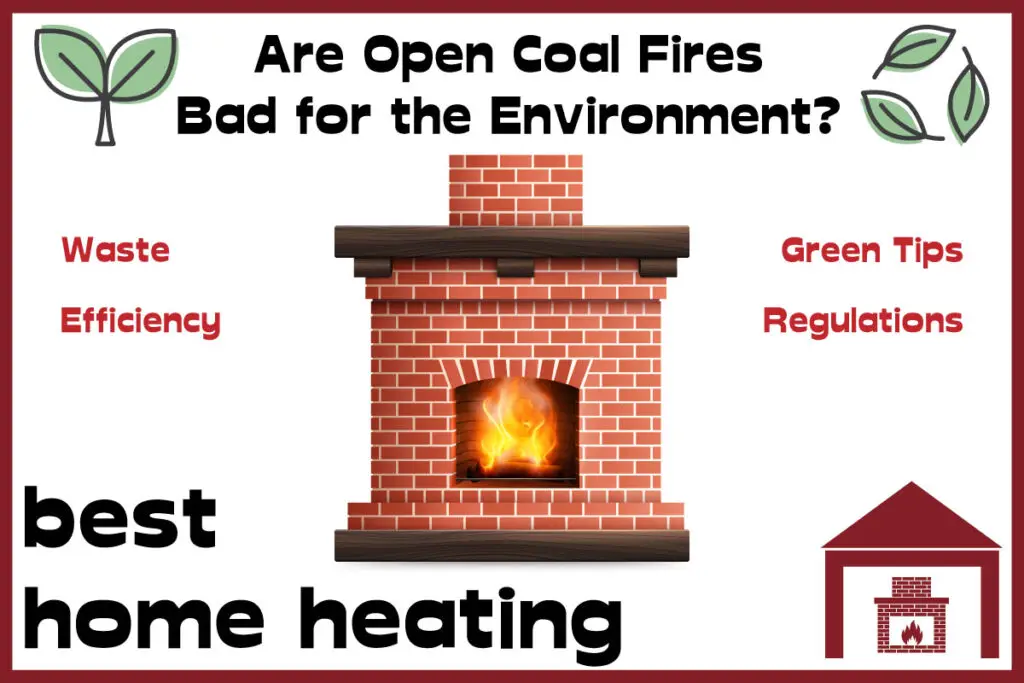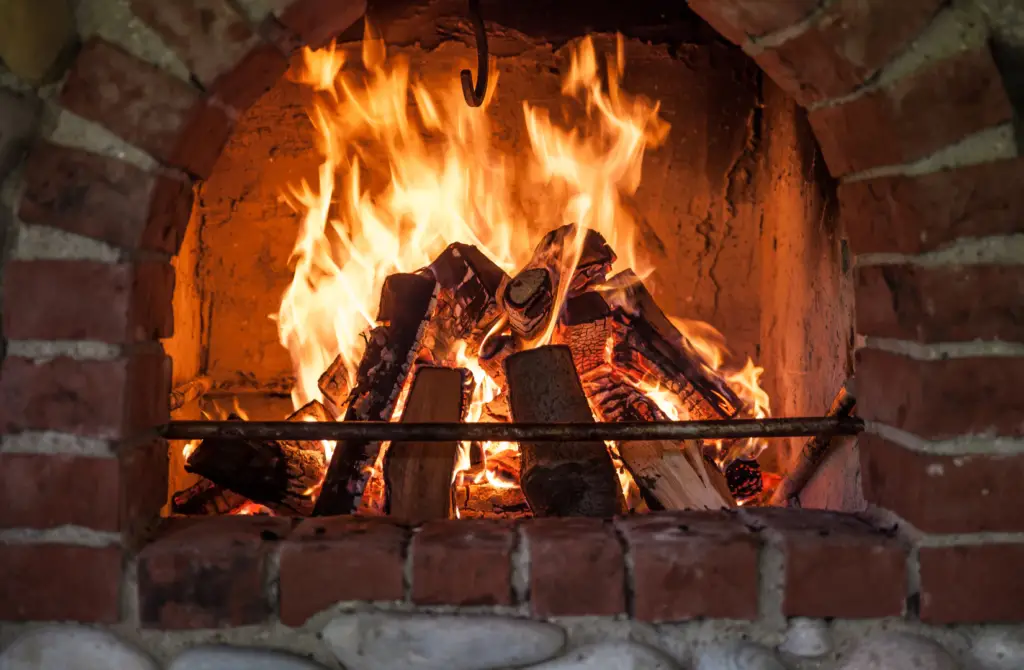Open fires in homes offer cozy warmth during winter, but their emission of harmful chemicals poses significant health and environmental risks, necessitating measures to mitigate their impact on the environment.
While people all over the world are increasingly becoming environmentally conscious, open fires are still a reality in many homes. A deeper understanding of the dangers of exposure to fumes and smoke can propel us toward a greener future.
Read on to discover more about the environmental impact of open fires, address pressing questions, and explore valuable tips to mitigate their effects in this post.

How do Open Coal Fires produce energy?
A conventional fireplace uses solid fuels such as coal or wood and produces radiant heat. The mechanism is as simple as it gets: coal is loaded onto a fire basket, and then ignited. Paper and wood are used to start the fire before coal is placed in the firebox. It produces smoke, which goes into the chimney.
The system heats by radiation, which means hot coals emit rays of heat that strike people and objects in the room and thus warm them up. Open fires are remarkably less efficient than more sophisticated heating systems, and have very little capacity for running radiators.
An open fire has to be refuelled frequently, and therefore it’s hard to keep the fire lit overnight, especially if it is burning wood. Coal stays lit for way longer than wood. The system produces soot, and therefore it’s important to sweep the chimney regularly.
What harmful products are produced by open fires?
No matter what type of solid fuel is used to make open fires, it produces harmful greenhouse gases. Frequently referred to as the dirtiest fossil fuel, coal is responsible for over 40% of the global carbon dioxide emissions. Coal consumption also releases nitrous oxide (N2O), which is another notable greenhouse gas.
The combustion of wood produces carbon dioxide (CO2), carbon monoxide (CO), nitrogen oxides (NOx), and sulphur oxides (SOx). Emissions of these gases contribute to climate change.
Burning treated wood and plastic is more dangerous, releasing toxic chemicals such as dioxin, and a plethora of heavy metals that cause serious health complications if inhaled.
If the ash in a fireplace is dispersed in the air, the inhabitants in the house inhale the ash particulates and run the risk of developing silicosis—a painful long-term lung disease characterised by symptoms such as shortness of breath, persistent cough, and tiredness.
Are open fires worse for the environment than gas central heating?
The short answer is yes. Open fires are worse than almost all other types of heating systems. An open fire requires air for combustion. The fire sucks air from the room, and ejects a portion of the heat and air through the chimney.
The air is gradually replaced by cold air from the outside. In other words, an open fire is not efficient because it draws in cold air from the outside. The fire has to consume more fuel to stay lit and keep the room comfortably warm. And burning more fuel means releasing more greenhouse gases.
That is not the case with a gas central heating system. The boiler uses gas to produce heat, and then hot water is pumped through radiators. The system is more efficient simply because all the heat it produces stays in the room.
A wood-burning stove is also remarkably more efficient than an open fire. While the former is up to 65% efficient, the latter is usually 10% efficient. At its best, an open fire can be 30% efficient.
Steel-made stoves also emit radiant heat, which makes them more efficient. From an environmental perspective, an open fire is a dirty and inefficient heating system, and therefore should be replaced with something more sophisticated.
Is there anything that can be done to reduce the environmental impact of open fires?
There are a few things you can do to reduce the environmental impact of open fires, at least to some extent. If you have to continue using your fireplace, try to follow these tips.
Burn cleaner fuels. Choose dry, clean and seasoned wood. Hard wood is denser than softwood, burns slowly, and produces less smoke. The wood should be dried for about 6 months before you burn it.
Replace your old fireplace with an EPA-certified fireplace insert or wood stove. Some wood pellet stoves are highly energy-efficient. They use less fuel and produce less smoke. You will end up saving money in the long term, and there will be less impact on the environment.
Be choosy about what you burn. Never burn trash, garbage, rubber, plastics, paints, petroleum products, solvents, or treated wood. When burned, they release toxic gases that are extremely harmful.
Avoid using large pieces of wood, and overloading your fireplace or stove. Clean ashes regularly and make sure the air intake vents are not clogged by excess ashes.
You can tell if the fire is burning properly just by looking at the smoke. If the fire is burning optimally, the smoke should look white. Dark and thick smoke indicates more pollutants.

Are there regulations controlling the use of open fires in homes?
In the UK, people can still legally use open fires but are required to use clean fuels such as manufactured solid fuels and dry wood, which produce less smoke. Suppliers of manufactured solid fuels are required to put a “ready to burn” logo to their products so that users can easily identify them as safe for use.
If wet wood is sold in large volumes, the sellers must provide advice on methods of drying the wood before burning. In addition, the sulphur content present in manufactured solid fuels must be low.
Homeowners who burn coal can continue to do so until May 2023, when selling and buying coal for domestic fireplaces will be fully banned. For now, homeowners must buy coal from their local approved coal merchants. If your house is located in a Smoke Control Zone, you cannot burn coal or wood on an open fire. You must use only smokeless fuels.
There are also some rules of bonfires to reduce the environmental impacts of open fires. If you deem the fumes and smoke of your neighbour’s open fires to be a statutory nuisance, you can complain to your council.
In the USA, the Environmental Protection Agency (EPA) has ordinances and regulations for fireplace inserts and wood-burning appliances. Homeowners are required to take measures to minimise the smoke generated by open fires.
Conclusion – Main Environmental Considerations when using an open fire to heat your home
Open fires are bad for your health and the environment, and ideally you should avoid using an open fire to heat your home. With that said, if you are not yet ready to switch to a more sophisticated heating system, try to be a bit strategic about the way you use an open fire.
Burn seasoned wood only, because wet wood produces a lot of smoke. Avoid non-wood products; some of them produce dangerous chemicals. Consider investing in an efficient heating system. A gas insert is relatively inexpensive, and can be easily installed. An open fire is significantly less efficient than a gas insert.
The bottom line is, if you want to use an open fire to heat your home, do that responsibly. It all comes down to minimising the environmental impact of your actions.
References:
- https://www.renfrewshire.gov.uk/article/2943/Solid-fuel-heating-systems#:~:text=Open%20fires%20have%20a%20fire,and%20ability%20to%20run%20radiators.
- https://home.howstuffworks.com/home-improvement/heating-and-cooling/fireplace2.htm
- https://www.clientearth.org/latest/latest-updates/stories/fossil-fuels-and-climate-change-the-facts/#:~:text=Coal%20is%20a%20fossil%20fuel,the%20world’s%20total%20carbon%20emissions.
- https://wood-energy.extension.org/what-are-the-air-emissions-of-burning-wood/#:~:text=When%20wood%20is%20burned%2C%20the,and%20nitrogen%20oxides%20(NOx).
- https://www.environment.nsw.gov.au/questions/open-fireplace-slow-combustion-wood-heater
- https://www.theguardian.com/notesandqueries/query/0,,-187807,00.html
- https://www.lincoln.ne.gov/files/sharedassets/public/health-dept/environmental/reducewoodburnairpollution.pdf
- https://www.gov.uk/garden-bonfires-rules
